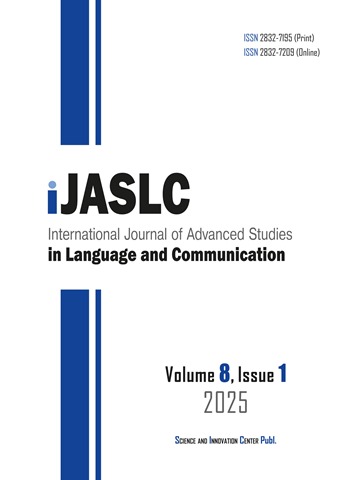AN ECOLINGUISTIC PERSPECTIVE ON EXPERIENCING NATURE IN FORESTS
Abstract
Analysing positive experiences of nature in forests from a linguistic perspective, the study aims to explore themes, emotions, and metaphors associated with natural green spaces as expressed in English. The method used is a qualitative approach, encompassing principles from ecolinguistics and cognitive linguistics. Through the analysis, appreciative discourses about forests are emphasised in shaping ecological awareness and harmonious behaviour towards nature.
EDN: NSFAOR
References
Nukarinen, T., Istance, H. O., Rantala, J., Mäkelä, J., Korpela, K., Ronkainen, K., Surakka, V., & Raisamo, R. (2020). Physiological and psychological restoration in matched real and virtual natural environments. In Extended Abstracts of the 2020 CHI Conference on Human Factors in Computing Systems (CHI EA '20) (pp. 1–8). Association for Computing Machinery. https://doi.org/10.1145/3334480.3382956
Na, Q., Nurmalinda, E., Rianto, R., Djati, S., & Rahmanita, M. (2024). Multisensory Experiential Tourism Strategies in Guangxi, China. TRJ Tourism Research Journal, 8(1), 111-126. https://doi.org/10.30647/trj.v8i1.247
Huang, G. & Zhao, R. (2021). Harmonious discourse analysis: approaching peoples’ problems in a Chinese context. Language Sciences, 85, 101365. https://doi.org/10.1016/j.langsci.2021.101365
Fredrickson, B. L., & Anderson, D. H. (1999). A qualitative exploration on the
wilderness experience as a source of spiritual inspiration. Journal of Environmental Psychology, 19(1). 21–39. https://doi.org/10.1006/jevp.1998.0110
Stibbe, A. (2021). Ecolinguistics: Language, ecology and the stories we live by (2nd ed.). Routledge.
Lakoff, G. & Johnson, M. (1980). Metaphors We Live By. The University of Chicago Press.
Kövecses, Z. (2020). Extended Conceptual Metaphor Theory. Cambridge University Press.
Oh, B., Lee, K. J., Zaslawski, C., et al. (2017). Health and well-being benefits of
spending time in forests: Systematic review. Environmental Health and Preventive Medicine, 22(71). https://doi.org/10.1186/s12199-017-0677-9
Doimo, I., Maseiro, M., Gatto, P. (2020). Forest and Wellbeing: Bridging Medical and Forest Research for Effective Forest-Based Initiatives. Forests, 11(791). https://doi.org/10.3390/f11080791
Corazon, S. S., Sidenius, U., Poulsen, D. V., Gramkow, M. C., & Stigsdotter, U. K. (2019). Psycho-Physiological Stress Recovery in Outdoor Nature-Based Interventions: A Systematic Review of the Past Eight Years of Research. International journal of environmental research and public health, 16(10), 1711. https://doi.org/10.3390/ijerph16101711
Norwood, M. F., Lakhani, A., Fullagar, S., Maujean, A., Downes, M., Byrne, J.,
Stewart, A., Barber, B., & Kendall, E. (2019). A narrative and systematic review of the behavioural, cognitive and emotional effects of passive nature exposure on young people: Evidence for prescribing change. Landscape and Urban Planning, 189, 71-79. https://doi.org/10.1016/j.landurbplan.2019.04.007
Fredrickson, B. L., & Levenson, R. W. (1998). Positive emotions speed recovery from the cardiovascular sequelae of negative emotions. Cognition and Emotion, 12(2), 191–220. https://doi.org/10.1080/026999398379718
Maller, C., Townsend, M., Pryor, A., Brown, P., & St Leger, L. (2006). Healthy nature healthy people: ‘contact with nature’as an upstream health promotion intervention for populations. Health promotion international, 21(1), 45-54.
Furuyashiki, A., Tabuchi, K., Norikoshi, K., Kobayashi, T, Oriyama, S. (2019). A comparative study of the physiological and psychological effects of forest bathing (Shinrin-yoku) on working age people with and without depressive tendencies. Environmental Health and Preventive Medicine, 1(4). https://doi.org/10.1186/s12199-019-0800-1
Mattila, O., Korhonen, A., Pöyry, E., Hauru, K., Holopainen, J., & Parvinen, P. (2020). Restoration in a virtual reality forest environment. Computers in Human Behavior, 107, 106295. https://doi.org/10.1016/j.chb.2020.106295
Yu, C.-P., Lee, H.-Y., & Luo, X.-Y. (2018). The effect of virtual reality forest and urban environments on physiological and psychological responses. Urban Forestry & Urban Greening, 35, 106-114. https://doi.org/10.1016/j.ufug.2018.08.013
Hejtmánek, L., Hůla, M., Herrová, A., & Surový, P. (2022). Forest digital twin as a relaxation environment: A pilot study. Frontiers in Virtual Reality, 3. https://doi.org/10.3389/frvir.2022.1033708
Kaushal, S., Dhammi, S., & Guha, A. (2022). Climate crisis and language – A
constructivist ecolinguistic approach. Materials Today: Proceedings, 49(8), 3581-3584. https://doi.org/10.1016/j.matpr.2021.08.093
Stibbe, A. (2012). Animals erased: Discourse, ecology, and reconnection with the natural world. Wesleyan University Press.
Lamb, G. (2024). Multispecies Discourse Analysis: The Nexus of Discourse and Practice in Sea Turtle Tourism and Conservation. Bloomsbury Advances in Ecolinguistics Series.
Stibbe, A. (2013). An Ecolinguistic Approach to Critical Discourse Studies. Critical Discourse Studies, 11(1), 117–128. https://doi.org/10.1080/17405904.2013.845789
Zhou, W. (2017). Ecolinguistics: Towards a new harmony. Language Sciences, 62, 124–138. https://doi.org/10.1016/j.langsci.2017.04.004
Zou, C. (2021). Ecological cognitive analysis of Chinese harmonious discourse. Frontiers in Psychology, 12. http://doi.org/10.3389/fpsyg.2021.713809
Lakoff, G. & Johnson, M. (1980). Conceptual metaphor in everyday language. The Journal of Philosophy, 77(8), 453–486.
Lan, C. & Jia, D. (2020). Conceptual metonymies and metaphors behind SHUI (WATER) and HUO (FIRE) in ancient and modern Chinese. Applied Linguistics Review, 11(2), 281–310. https://doi.org/10.1515/applirev-2017-0132
Gibbs, G. R. (2007). Analyzing Qualitative Data. SAGE Publications, Ltd.
https://doi.org/10.4135/9781849208574
Friese, S., Soratto, J., & Pires, D. (2018). Carrying out a computer-aided thematic content analysis with ATLAS.ti. MMG Working Paper, (18-02).
Copyright (c) 2025 A. Soloshenko

This work is licensed under a Creative Commons Attribution-NonCommercial-NoDerivatives 4.0 International License.
Authors who publish with this journal agree to the following terms:
- Authors retain copyright and grant the journal right of first publication with the work simultaneously licensed under a Creative Commons Attribution License that allows others to share the work with an acknowledgement of the work's authorship and initial publication in this journal.
- Authors are able to enter into separate, additional contractual arrangements for the non-exclusive distribution of the journal's published version of the work (e.g., post it to an institutional repository or publish it in a book), with an acknowledgement of its initial publication in this journal.
- Authors are permitted and encouraged to post their work online (e.g., in institutional repositories or on their website) prior to and during the submission process, as it can lead to productive exchanges, as well as earlier and greater citation of published work (See The Effect of Open Access).



